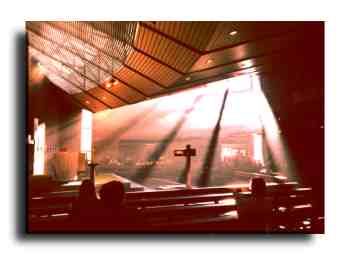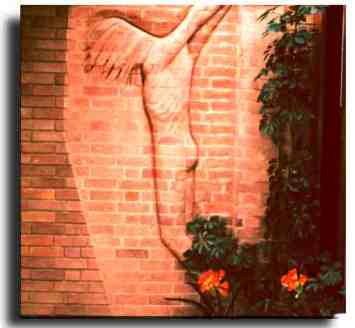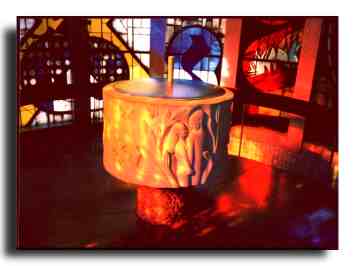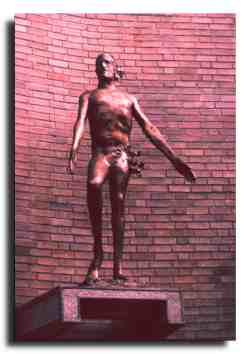
Tel: 0121-744-1967
Fax: 0121-733-6998
REGISTERED AS A CHARITY 234216
Begun in 1965, the Church was completed in 1966. It replaced the original Church built in 1937 which is now the Parish Hall. The architect was Brian Rush, a local architect, who was at the start of a career, which went on to include the building of many fine Churches especially in the Midlands. Further inspiration came from Fr Paddy O' Mahony the parish priest from 1962 to 1991.

The Church is best entered and viewed from the Main Entrance on the Stratford Road.
On entering through the main door we find ourselves in a light filled Narthex or Porch. Here we first notice the plants of different kinds which are such a feature of the Church. They symbolise the life and growth which is natural in our world . They remind us too that we are called to growth in our spiritual lives as children of God. We can see into the Main Church through the large glass screen.
To the left, we see a picture of Fr O' Mahony and a list of the benefactors who gave so generously to equip and beautify the new Church. Also on the left, there is a very moving brick sculpture of the Crucifixion by Walter Ritchie, a local artist based in Kenilworth, whose work is such a feature of the Church. By the main door there is the striking sculpture of 'Peace in our time' showing the murdered dove of peace. This was given to Fr O'Mahony by its sculptor Angelo Bordonari , in tribute to his well known work for justice and peace.

On the right we see the Baptistery. Through the sacrament of Baptism men and women become children of God and members of the Church. In the centre is the Font made from Portland Stone and carved with images of human and animal life and creation.

The surrounding stained and painted glass is by Tom Fairs. It depicts in three scenes the Passovers of the Old Testament (desert, pillar of fire, sea) and New Testament (tomb/womb, cross, fingers/gifts of the Holy Spirit ) and the Resurrection ( a flash of light and energy, the five wounds of Christ). Around the Baptistery, there is a swirling water cascade which reminds us of the living , life filled water of Baptism . It incorporates a holder for the Paschal Candle, symbol of the Risen Christ, the Light of the World.
Up the steps on the left leads us into the Day Chapel. This small chapel can be used for weekday worship and for small groups. It affords a full view of the main church through the large window and has linked speakers so it can be used for very noisy babies and young children during the Sunday Services.
Around the walls there is vari-coloured Stained Glass, reminiscent in a small way of the glass in Coventry Cathedral nave which speaks of the different stages of life , from birth to death and after life. On the wall by the glass screen is a full size sketch of the Crucified Christ by Walter Ritchie for the sculpture in Narthex.
From the Day Chapel we move through the folding doors (another interesting detail of the Church) into the Main Chapel. The whole Church is encompassed in one space which is dominated by the figure of the Risen Christ by Dame Elizabeth Frink, 1930 -1993, one of the most famous women sculptors of the century. This must be one of her earliest religious figures. She was given the challenging task of showing the Risen Christ who greeted the apostles and disciples after the Resurrection in a body somehow recognisably the same but in some mysterious way different , bearing the five wounds of the Passion. It is said that viewed from the left we can see the Jewish aspect of Christ with the beard and the more Semitic features whereas from the right Christ is seen as more like the Olympic hero of the Greeks who has conquered and wears the laurel crown of the victor. The New Testament especially in the writings of John and Paul represents Jesus from both Greek and Hebrew points of view.

Below the statue we see the large Altar made of a single block of Portland stone weighing seven tons. On the front we see the text from St John ; ' I will pour out my spirit on all flesh'. This lettering was carved by Walter Ritchie, who incidentally was a pupil of Eric Gill. To left and right of the altar stand two large ceramic altar candlesticks, made locally at Henley in Arden, and reminiscent of those in Coventry Cathedral. Note on the wall the simple Stations of the Cross an aid to contemplation and prayer as we recall Our Lord's journey to Calvary and death.
Behind the altar and growing up the wall towards the natural diffused light coming in above the sanctuary are many different kinds of plants, with their different texture and shapes, first encountered in the Narthex. The Altar is positioned carefully so that the congregation is gathered on three sides creating a sense of gathered community sharing in the worship of the parish. Four hundred people can be accommodated very close to the Sanctuary. At the back we see the Gallery with its cantilevered supports, useful for occasions and the great festivals when the Church is particularly crowded.

Over to the right of the Main Church is the Lady Chapel with its beautiful carved figure of the Mother and Child gazing across the church. It was carved from a single piece of teak by Walter Ritchie. Mary clasps the naked, vulnerable child protectively. Carved into the brickwork behind is a line from Gerard Manley Hopkin's poem. Behind the altar is some stained and painted glass by Tom Fairs, which suggests by its shapes and colours fruits, recalling Mary, Mother of God, as honoured in the prayer : 'Blessed is the fruit of thy womb, Jesus,' and the fruits of the Holy Spirit.
The Church uses natural materials in a simple and pleasing way ; brick for the walls, glass in the windows and wood on the floor and ceiling , stone for the sanctuary. From inside and from many different angles, glimpses can be seen of the world outside.The result is a very beautiful Church with an atmosphere of beauty, harmony and peace which still after thirty years speaks to the human spirit today of the things of God.
Details of the parish's charitable works
Back to Our Lady of the Wayside home page
CJM: wonderful music for contemporary Catholic mass and more
This page has been visited times since February 9 1999